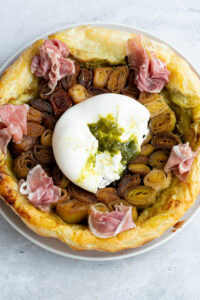This post may contain affiliate links, which means I’ll receive a commission if you purchase through my links, at no extra cost to you. Please read full disclosure for more information.
😋 Pizza like in Italy
Do you dream of a soft pizza that reminds you of Italy? Would you like to go to Italy to taste real pizza? You don't have to go that far, it can be right there on your plate. Granted, you'll need a little patience for this...but frankly, this recipe is so worth it!
I think that, as with bread, buns or pasta, there are as many recipes as there are pizzaiolo. Today, I'd like to share with you mine, which I've been working on and perfecting for some time to achieve this delicious result!

💙 Why you'll love this recipe
- It's absolutely delicious and takes you all the way to Italy.
- It's infinitely adaptable
- It's great to share with family and friends.
😍 An adaptable trim
You can replace the mozzarella with another cheese of your choice, but drain it a few minutes beforehand: if it gets too wet, it will soak the dough. When cooked, you risk having a cooked outside but a raw inside. You can use homemade tomato sauce or not, add grilled eggplant (when it's in season), fresh herbs, add Parma ham or pancetta... in short, the pizza possibilities are endless!
🐹 Are there any vegan alternatives?
If you'd like to veganize this recipe, it's very simple: just replace the mozzarella and Parmesan with the fauxmages of your choice!
📝 Note to vegetarians
Many cheeses contain animal rennet (a coagulant that transforms milk into cheese by curdling it). There is mozzarella without animal rennet, you just have to look carefully at the product. However, to my knowledge, there is no Parmesan cheese without animal rennet.
To be sure the cheese you buy is vegetarian, look for the words "suitable for vegetarians". You can also look at the list of ingredients: if you see "rennet", it's 99% animal-based. On the other hand, if you see "microbial coagulant", "microbial enzymes" or "vegetable rennet", the product is vegetarian. There's also a "V-label" (a green V on a yellow background) indicating that the product is vegetarian or vegan. If you see an "IGP", "AOP" or "Label Rouge" label, animal rennet is automatically used in the product in question.
🍬 Baker's yeast: fresh, instant dry, active dry or liquid
Baker's yeast is most often used in pizza doughs, brioches, viennoiseries, breads etc... I use it here for pizza dough, as it's what makes it rise. If, like me, you've been struggling for a long time, this section is for you!
It comes in four different forms:
- Fresh baker's yeast: in cubed form, it is often found in the fresh bread or cake section of supermarkets. Alternatively, you can buy it directly from a bakery.
- Instant dried yeast: usually in small 5-gram sachets. I think Francine's "instant baker's yeast" is really great*. To use it, put it directly into the flour and mix well.
- Active dry yeast: in the form of small granules, often in 8-gram sachets. Before using, rehydrate it in lukewarm water or milk (be careful, if it's too hot it will kill the yeast) according to your recipe, for a quarter of an hour.
- Liquid yeast: generally found in bakeries in small jars, it is incorporated directly into the dough.
In any case, never put your yeast in direct contact with salt, otherwise it will cancel out its properties.
🧄 Which garlic to choose?
Feel free to have a look at the Eco Tips I wrote on garlic Without knowing it, you may be condoning theslavery andexploitation of Chinese prisoners... Garlic from China can also be very unhygienic!
💡 Tips for making the best pizzas
- No air during rising : to ensure successful rising, place your pizza dough in a large bowl (it will expand, so it shouldn't be cramped) and cover with cling film or bee-wrap. We often read that a clean dishcloth is enough, but this is not the case: air must not pass through the cloth.
- The importance of a long resting time The secret of true Italian pizzaiolo is resting the dough. My very first pizzas rested for just 2 hours, and they were nothing like the ones I'm offering you today, which rise for 48 hours: much softer, much better tasting, crisp edges and a real pizza look. So yes, it's a bit long, but it's totally worth it!
- Theimportance of low-temperature fermentation: with dough rising in the fridge, the dough tastes much better but is also better digestible.
- Norolling pin for shaping: use your hands, it's very satisfying and allows the air to circulate well without crushing it (which would be the case with a rolling pin, for example). Start at the center of the pizza and gently push towards the edges with your fingertips, stretching the dough.
- Drain your mozzarella briefly so that it doesn't soggy up the dough (see above).
- No pizza oven for baking? It doesn't matter In restaurants, pizzas are cooked in pizza ovens, but not everyone, including me, is lucky enough to have one at home! I'm going to use my traditional oven, but I'm going back to the restaurant principle: quick cooking at a very hot temperature, using the static heat/natural convection mode.
😇 Conservation
I recommend that you eat your pizza within 24 hours of baking. To reheat, just pop it in the oven and you're done!
If you want to freeze your dough, no problem: just place the ball in a freezer bag, remove as much air as possible and place in the freezer. You can keep it like that for 1 to 2 months.
🎥 The step-by-step video recipe just below
📖 Recette

Pizza Margherita avec des bords fourrés à la mozza
Équipement
- Un four
- Un robot (optionnel)
- Film alimentaire ou un bee-wrap
- Scotch
Ingredients
Pour la pâte
- 375 g de farine italienne 00, avec 12% de protéines
- 5 g de levure boulangère instantanée sèche
- 225 g d' eau tiède
- 21 g d' huile d'olive vierge extra
- 2 cuillères à café de sel fin
Pour la garniture
- 150 g de sauce tomate épaisse
- 1 bonne cuillère à soupe de double concentré de tomate
- 1 petite cuillère à café d' ail en semoule
- Un peu d' origan
- Un peu de thym
- 500 g de mozzarella
- 50 g de Parmesan râpé
- Quelques feuilles de basilic
- La salade de votre choix pour l'accompagnement (optionnel)
Instructions
La pâte
- Commencez d'abord par faire la pâte : mélangez la farine et la levure instantanée. Rajoutez petit à petit l'eau tiède, le sel puis l'huile d'olive. Malaxez bien la pâte, soit à la main soit avec un robot, jusqu'à obtenir une boule lisse.
- Mettez-la dans un grand bol (la pâte à pizza va lever, il ne faut donc pas qu'elle soit à l'étroit), déposez un léger filet d'huile d'olive sur le dessus et étalez-le avec vos mains. Recouvrez ensuite d’un film plastique ou d'un bee-wrap et mettez-la au frigo pendant 48 heures (je sais, c'est long mais croyez-moi, ça change tout !).
- Une fois que la pâte a reposé, récupérez-la et laissez-la lever 2 heures à température ambiante (dans un endroit à 28-30°C).
- Coupez-la en deux moitiés égales. Arrosez d'huile d'olive la plaque de votre four et étalez-la avec un pinceau ou un mouchoir (ou à défaut, vos doigts),. Mettez la première boule et étirez-la avec vos doigts : commencez par le centre de la pizza et délicatement avec le bout de vos doigts, poussez vers les bords et étirez la pâte jusqu'à obtenir une jolie forme ronde.
La garniture
- Occupez-vous enfin de la garniture : dans un bol, mélangez la pulpe de tomateavec le concentré de tomate, l'ail, l'origan, le thym et le Parmesan. Répartissez le tout en fines couches sur le dessus, puis ajoutez la moitié de la mozzarella, coupée en tranches.
- Déposez l'autre moitié de la mozzarella, coupée en petits morceaux, sur les rebords de votre pizza et petit à petit, rabattez-les bords.
- Préchauffez le four à 300°C (ou le plus chaud que votre four puisse aller) en mode convection naturelle/chaleur statique haut et bas, et faites-la cuire sur l'étagère du milieu entre 5 et 8 minutes : attention, surveillez souvent la pizza, ça peut brûler très vite et chaque four est différent !
- Retirez-la du four, rajoutez le basilic et dégustez-la avec la salade de votre choix. Répétez l'opération pour la seconde pizza.
Notes
- Le temps de cuisson dépend de votre four, chaque four étant différent.





Répondre